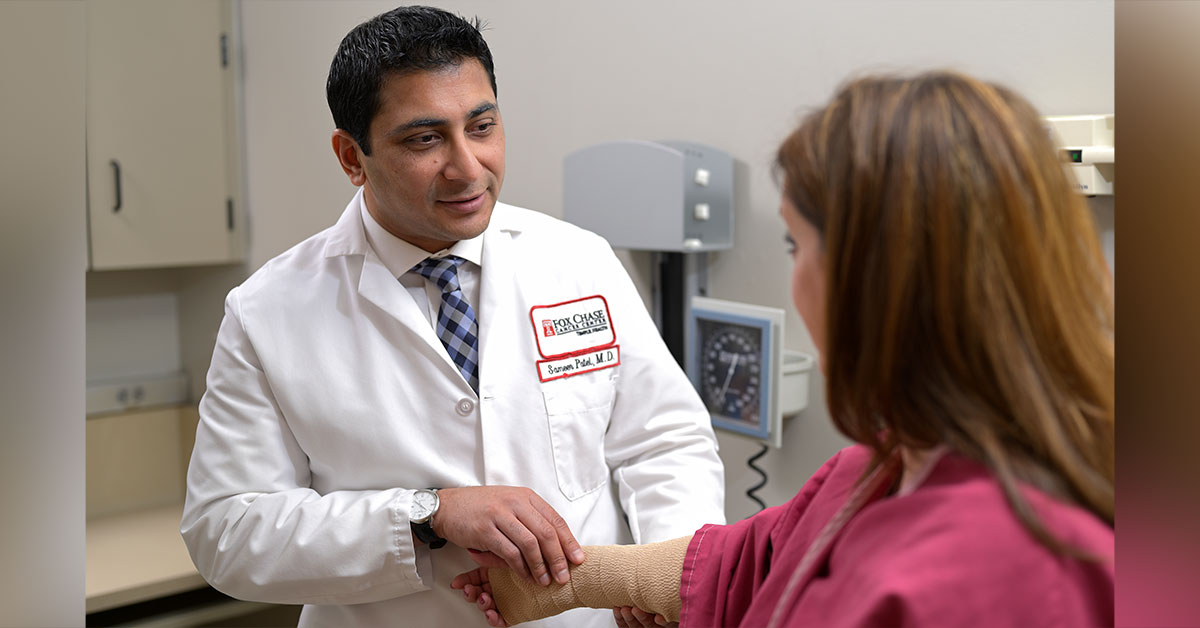
Getting the Right Kind of Help for Lymphedema: Why it Matters
-
One possible complication of certain types of cancer treatment is lymphedema, a persistent buildup of fluid that often causes swelling, usually in an arm or a leg. It often occurs in women and men with breast cancer who have had lymph nodes removed as part of diagnosis or treatment.
But any patient whose lymph system has been damaged is vulnerable. People who’ve had lymph nodes removed in the underarm, groin, pelvis, or neck—or radiation treatments to those areas—are particularly at risk.
A compromised lymphatic system
One role of the lymphatic system is to circulate a fluid called lymph, which contains disease-fighting white blood cells, throughout the body.
In someone with a damaged lymph system, instead of that fluid circulating freely, it can build up and cause abnormal swelling. Lymphedema can develop during cancer treatment or even years later. And once it starts, it can be treated, but it can’t be cured.
Left untreated, lymphedema can make a limb or other affected area swell far out of proportion to the rest of the body. It can also limit movement, harden skin, and cause wounds and infections.
“With careful treatment, lymphedema can be controlled—and the earlier that treatment starts, the better the response,” said Jeannie Kozempel, PT, DPT, MS, manager of physical medicine and rehabilitation at Fox Chase Cancer Center.
Physical or occupational therapy plays a key role in successful treatment.
Exercise—a mainstay of lymphedema treatment
Not so long ago, cancer survivors with lymphedema were advised to avoid exercise out of concern that it might make symptoms worse.
But research now shows that exercise is not only safe but can even reduce the risk of swelling flare-ups. A key reason: “When you use muscles to exercise, they act like a pump that pushes lymph fluid away from the affected area, decreasing swelling,” Kozempel explained.
Still, overstressing a limb or other affected area can be harmful. Consequently, anyone with lymphedema should see a certified lymphedema therapist—one with special training to manage the disease—before starting to exercise, the American Cancer Society cautions.
Particularly if you’ve been diagnosed with lymphedema, “exercise is medicine for your body—you need to do it at the correct dose and intensity,” Kozempel said.
A certified therapist can custom design a safe and sensible exercise program for you, to help manage your lymphedema and improve your overall fitness without straining the affected area. Many of the physical and occupational therapists at Fox Chase are certified in lymphedema therapy by the Lymphedema Association of North America (LANA).
Comprehensive help in treating lymphedema
As beneficial as it is, therapeutic exercise is only part of the lymphedema treatment certified therapists provide.
Lymphedema is also controlled with compression garments, such as a snug stocking or sleeve. Careful fitting is crucial—a stocking or sleeve that doesn’t fit properly may make lymphedema worse. Your therapist will see that yours fits well.
In addition to compression garments, lymphedema can often be managed in its early stages with elevation of the affected limb, as well as exercise. But for more severe swelling, your therapist may use a treatment called complete decongestive therapy (CDT), Kozempel said. It combines a special type of massage with other methods of decreasing swelling—including bandaging, exercise, and compression garments—and covers skin care as well.
CDT requires sessions, ideally with a highly experienced and certified therapist, and an individualized schedule is developed. The type of CDT offered at Fox Chase is the internationally recognized treatment of choice for lymphedema.
Surgical Options
If after treatment for lymphedema you don’t see an improvement in swelling or relief in pain, the plastic and reconstructive surgeons at Fox Chase offer two microsurgical options to patients for whom conventional lymphedema treatment hasn’t been effective. Fox Chase is one of the few centers on the East Coast to offer these options called Vascularized Lymph Node Transfer (VLNT) and Lymphovenous Bypass (LVBP).
Find out more about surgical options for lymphedema here.
Reducing your risk
What if you’re a cancer survivor who doesn’t have lymphedema but is at risk for it—for example, because you’ve had lymph nodes removed?
Then it also pays to consult with a certified lymphedema therapist who can design a personalized home exercise program for you. It can help you:
- Avoid weight gain, which raises the risk of lymphedema.
- Exercise safely so that you don’t strain your body in a way that raises your risk.
Your therapist can also regularly assess the size of any part of your body likely to be affected by lymphedema. Any increase in size indicates lymphedema may be developing. “Early detection and treatment are the best ways to successfully manage lymphedema,” Kozempel emphasized.
For several years now, Fox Chase has offered an early intervention lymphedema program for all breast cancer patients and others at risk for the condition.
All participants are monitored before treatment for any signs of abnormal swelling and then followed every few months for two years so that lymphedema can be detected in its earliest, most treatable stages. Participants’ overall strength and mobility are also monitored. For information, call 215-728-2592.
Find out more about the Lymphedema Support Group at Fox Chase, which meets quarterly in the evening.
